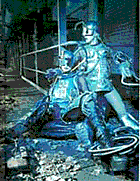2.7. Cyborg: Being Human in a Mediated Age
What is true for the big cultural determining ideas of whole societies and ages that is true the same way for the ideal of life of every single individual. - Günter Dux
![]()

 When digital technologies are becoming smaller and smaller, faster
and faster, these technologies invade our body. Computers become
tiny enough to implant them in the body or to wear them like you
wear clothes nowadays. Today you can wear already mobile phones
with internet-access, GPS-(Global Positioning System)receiver
and virtual headsets for 'augmented reality', devices which add
reality with information like maps or construction-plans. From
notebooks, palmtops and wristwatch-computers to IBM's Personal Area Network (PAN) it is only a small step.
When digital technologies are becoming smaller and smaller, faster
and faster, these technologies invade our body. Computers become
tiny enough to implant them in the body or to wear them like you
wear clothes nowadays. Today you can wear already mobile phones
with internet-access, GPS-(Global Positioning System)receiver
and virtual headsets for 'augmented reality', devices which add
reality with information like maps or construction-plans. From
notebooks, palmtops and wristwatch-computers to IBM's Personal Area Network (PAN) it is only a small step.
 The perfectly mediated human-machine-hybrid is described by the
science fiction author Neal Stephenson in Snow Crash 1992 as 'lametta':
A cyborg living in stereo-reality, navigating his body through
reality while navigating his avatar through cyberspace. But it
is not only science ficition. As Donna Haraway argues "the boundary
between science fiction and social reality is an optical illusion.[..]
By the late twentieth century, our time, a mythic time, we are
all chimeras, theorized and fabricated hybrids of machine and
organism; in short, we are cyborgs. The cyborg is our ontology."
(Haraway 1991: 149f.) These cyborgs "seem to inhabit incommensurable
regions of space-time, and to demand different literary and historical
chronotopes for their description and narration. These entities
do not seem able to share the same evolutionary story."(Haraway
1995: XI)
The perfectly mediated human-machine-hybrid is described by the
science fiction author Neal Stephenson in Snow Crash 1992 as 'lametta':
A cyborg living in stereo-reality, navigating his body through
reality while navigating his avatar through cyberspace. But it
is not only science ficition. As Donna Haraway argues "the boundary
between science fiction and social reality is an optical illusion.[..]
By the late twentieth century, our time, a mythic time, we are
all chimeras, theorized and fabricated hybrids of machine and
organism; in short, we are cyborgs. The cyborg is our ontology."
(Haraway 1991: 149f.) These cyborgs "seem to inhabit incommensurable
regions of space-time, and to demand different literary and historical
chronotopes for their description and narration. These entities
do not seem able to share the same evolutionary story."(Haraway
1995: XI)  They may not share the same evolutionary story, but they become
socialized as Cyborgs. These Cyborgs relive in their ontogenesis
the paradigm-shift from reality to virtual reality that happened
in the phylogenesis of mankind. Two basic forms of the futuristic
humans, posthumans or transhumans become therefore produced: "a
bio/machine hybrid of any desired form; and one not biological
at all: an 'electronic life' on the computer networks. Human as machine, and human in machine." (Leary 1994: 199)
They may not share the same evolutionary story, but they become
socialized as Cyborgs. These Cyborgs relive in their ontogenesis
the paradigm-shift from reality to virtual reality that happened
in the phylogenesis of mankind. Two basic forms of the futuristic
humans, posthumans or transhumans become therefore produced: "a
bio/machine hybrid of any desired form; and one not biological
at all: an 'electronic life' on the computer networks. Human as machine, and human in machine." (Leary 1994: 199)
Both concepts are Cyborg-concept as they are concepts of mediated bodies, but the 'human in machine' concept goes further. It realises that virtual reality works much better without a body. "Virtual reality strives for substituting the outer world and has no message for the body, that lives within. The cognitive shift that we experience in our relation to the earth, is , that we are making ourselves redundant at the moment. VR and also the biosphere function much better without the human." (Bilwet 1994: 205 - transl. S.J.) 'Human in machine' realises that also for humans, living in cyberspace is possible and so terminal identities are in their making.
What possibilities and risks are involved in living in the fourth dimension of cyberspace and Cyberia? How can we live a life there?
But first of all, how can we view the relation between organism and machine, between human and computer? How becomes 'wetware', the interface or connection between hardware and organism described from a mediatheoretical point of view?
![]()